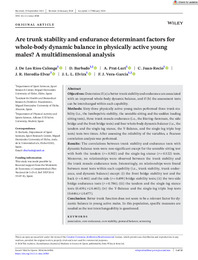Please use this identifier to cite or link to this item:
https://hdl.handle.net/11000/37926Full metadata record
| DC Field | Value | Language |
|---|---|---|
| dc.contributor.author | De los Ríos Calonge, Javier | - |
| dc.contributor.author | Prat-Luri, Amaya | - |
| dc.contributor.author | Juan-Recio, Casto | - |
| dc.contributor.author | Heredia-Elvar, Juan Ramón | - |
| dc.contributor.author | López Elvira, José Luis | - |
| dc.contributor.author | Vera García, Francisco J. | - |
| dc.contributor.other | Departamentos de la UMH::Ciencias del Deporte | es_ES |
| dc.date.accessioned | 2025-11-06T13:32:31Z | - |
| dc.date.available | 2025-11-06T13:32:31Z | - |
| dc.date.created | 2024 | - |
| dc.identifier.citation | Scandinavian Journal of Medicine & Science in Sports | es_ES |
| dc.identifier.issn | 1600-0838 | - |
| dc.identifier.issn | 0905-7188 | - |
| dc.identifier.uri | https://hdl.handle.net/11000/37926 | - |
| dc.description.abstract | Objectives Determine if (a) a better trunk stability and endurance are associated with an improved whole-body dynamic balance, and if (b) the assessment tests can be interchanged within each capability. Methods Sixty-three physically active young males performed three trunk stability (i.e., the lumbopelvic stability, the unstable sitting and the sudden loading sitting tests), three trunk muscle endurance (i.e., the Biering–Sørensen, the side bridge and the front bridge tests) and four whole-body dynamic balance (i.e., the tandem and the single-leg stance, the Y-Balance, and the single-leg triple hop tests) tests two times. After assessing the reliability of the variables, a Pearson correlation analysis was performed. Results The correlations between trunk stability and endurance tests with dynamic balance tests were non-significant except for the unstable sitting test with both the tandem (r = 0.502) and the single-leg stance (r = 0.522) tests. Moreover, no relationships were observed between the trunk stability and the trunk muscle endurance tests. Interestingly, no relationships were found between most tests within each capability (i.e., trunk stability, trunk endurance, and dynamic balance) except: (i) the front bridge stability test and the back (r = 0.461) and the side (r = 0.499) bridge stability tests; (ii) the two side bridge endurance tests (r = 0.786); (iii) the tandem and the single-leg stance tests (0.439 ≤ r ≤ 0.463); (iv) the Y-Balance and the single-leg triple hop tests (0.446 ≤ r ≤ 0.477). Conclusion Better trunk function does not seem to be a relevant factor for dynamic balance in young active males. In this population, specific measures are needed as the test interchangeability is questioned. | es_ES |
| dc.format | application/pdf | es_ES |
| dc.format.extent | 12 | es_ES |
| dc.language.iso | eng | es_ES |
| dc.publisher | Wiley | es_ES |
| dc.relation.ispartofseries | 34 | es_ES |
| dc.relation.ispartofseries | 3 | es_ES |
| dc.rights | info:eu-repo/semantics/openAccess | es_ES |
| dc.rights | Attribution-NonCommercial-NoDerivatives 4.0 Internacional | * |
| dc.rights.uri | http://creativecommons.org/licenses/by-nc-nd/4.0/ | * |
| dc.subject | Association | es_ES |
| dc.subject | Core endurance | es_ES |
| dc.subject | Core stability | es_ES |
| dc.subject | Postural balance | es_ES |
| dc.subject | Screening | es_ES |
| dc.subject.other | CDU::7 - Bellas artes::79 - Diversiones. Espectáculos. Cine. Teatro. Danza. Juegos.Deportes | es_ES |
| dc.title | Are trunk stability and endurance determinant factors for whole-body dynamic balance in physically active young males? A multidimensional analysis | es_ES |
| dc.type | info:eu-repo/semantics/article | es_ES |
| dc.relation.publisherversion | https://doi.org/10.1111/sms.14588 | es_ES |

View/Open:
2024 SJMSS_De Los Ríos-Calonge et al. Lack of correlation CS CE WWB.pdf
745,13 kB
Adobe PDF
Share:
.png)
